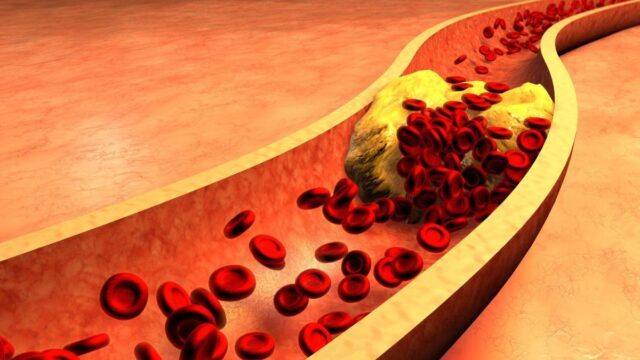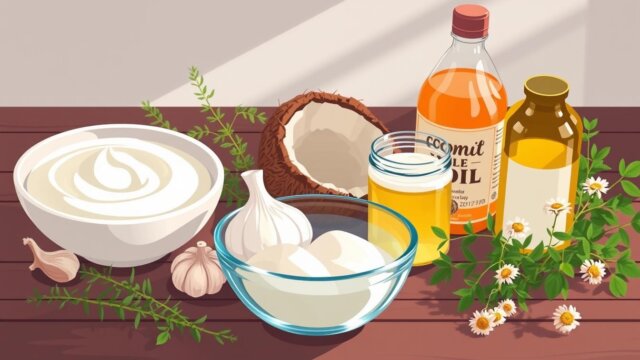FTC disclaimer: This post may contains affiliate links and we will be compensated if you click on a link and make a purchase.
Cholesterol is a type of blood fat, also known as a lipid, produced by the liver. It is a waxy steroid that is transported in the blood plasma throughout the body.
Cholesterol is also found in foods derived from animal sources like eggs, meats, and whole-fat dairy products, including milk, cheese, butter, and even ice cream.
Moreover, it is crucial for normal body functioning. Cholesterol is essentially needed to make vitamin D as well as some hormones.
Cholesterol exists in the outer layers of every cell in our body and helps build cell walls and create bile salts that help in fat digestion.
The body produces all the cholesterol that the body needs, and the cholesterol that we take from foods is known as dietary cholesterol.
The word ‘cholesterol’ comes from the Greek word “cholestereos.” “Chole” means “bile,” and “stereos” means “stiff.”
What is Cholesterol?
The amount of cholesterol in your bloodstream is one of the primary indicators used by health practitioners to alert individuals at risk for cardiac events.
Cholesterol is a fat-like, waxy substance found in your bloodstream and all your cells.
Studies have shown that cholesterol reduction can significantly decrease cardiac events (heart attack, bypass, angioplasty, stent placement, and cardiac death).
What is good about cholesterol?
Cholesterol does have a good side. It is essential for good health, serving many critical functions in the brain and the body.
Brain functioning
It is required for the brain to form the “synapses” that permit nerve cells to communicate, leading to learning and memory.
Essential for hormones
It is essential for all of the steroid hormones, such as testosterone, estrogen, and stress hormones, and important for the health and function of every membrane of every cell.
Assist fat-soluble vitamins
It is important for protection against toxins and the carriage of vital fat-soluble vitamins.
Our body makes cholesterol.
The liver produces about 80% of your body’s cholesterol to meet these vital functions. The rest comes through dietary intake.
On the other hand, excessively high cholesterol in the blood can produce heart disease — which is the leading cause of death.
Your body makes all the necessary cholesterol it needs. But when you eat too many refined carbohydrates and foods high in cholesterol and trans fat or have other risk factors, the excess cholesterol builds up in your arteries.
Further, it blocks blood flow and, if left untreated, can set the stage for a heart attack or stroke.
Some people can eat foods high in cholesterol and still have low blood cholesterol levels. In this case, it depends on what type of cholesterol you are consuming.
Similarly, it’s possible to eat foods low in cholesterol and have a high blood cholesterol level. This case will depend on the consumption of high simple carbohydrates foods that indirectly trigger high cholesterol.
What are LDL and HDL Cholesterol?
LDL Cholesterol
The LDL (low-density lipoprotein, the “bad” cholesterol), at elevated levels, may potentially cause cholesterol deposits, known as plaque, in the artery walls, increasing the risk for heart problems.
LDL is considered “bad” at 160 or more.
HDL Cholesterol
HDL (high-density lipoprotein) is the “good” cholesterol.
The HDLs transport excess cholesterol from peripheral tissue to the liver, where it is broken down and becomes part of bile.
HDL is considered “good” cholesterol in our body because it transports cholesterol destined for degradation and elimination.
An HDL level of 35 – 60 is considered OK. And, when the cholesterol level is above 60, then it helps in protecting against heart disease.
Moreover, cholesterol is involved in brain functioning, protecting the cerebral arteries and the coronary arteries, as per research.
Recent research suggests the risk associated with having low HDL levels (even if our total cholesterol and LDL levels are low) appears to have a greater impact on our health.
In those with such conditions, atherosclerosis underlies cardiovascular disease is likely to progress despite their low LDL levels.
Other Risk Factors for Heart Disease and Heart Attack
Triglycerides
A triglyceride is a type of fat that is stored in our body and circulates in our bloodstream.
As most fatty food contains triglycerides, the fat food when we eat is carried in the blood and affects the triglycerides level.
When we eat fatty food, blood triglyceride increases 2-4 times and reaches its maximum value in about 5 hours after the meal.
Our liver also synthesizes triglycerides. The blood’s triglyceride concentrations vary considerably throughout the day, depending upon how much fat you have eaten and how fast your body removes fat from the blood.
Unfortunately, many physicians or doctors focus too much on cholesterol and ignore other crucial factors like triglycerides.
According to research, triglycerides are a major risk factor in heart disease.
Excess levels will thicken your blood, making it “sludgy,” which in turn leads to a risk of clotting, possibly causing a blockage leading to a heart attack or stroke.
Ideally, the triglyceride level in blood should be less than 250 milligrams per deciliter (mg/dL).
Homocysteine
Over the past few years, the high levels of homocysteine (a sulfur-containing amino acid) have been linked to increased risk of heart diseases such as premature coronary artery disease, stroke, and thromboembolism (venous blood clots).
Moreover, it is also prevalent among people who have normal cholesterol levels.
In the case of “abnormal” homocysteine levels, it appears to contribute to atherosclerosis in at least three ways:
- The direct toxic effect of homocysteine damages the cells lining inside of the arteries.
- Interference with clotting factors
- Oxidation of low-density lipoproteins (LDL).
Normally, it is automatically cleared out of the arteries quickly and is not a problem in most people.
Recent studies have suggested that elevated blood homocysteine levels are as important as high blood cholesterol levels and can operate independently.
Elevated homocysteine levels may occur among people whose diet contains inadequate amounts of folic acid, vitamin B6, or vitamin B12.
This deficiency prevents your body from producing the enzymes needed to remove homocysteine from your blood.
Dietary supplementation that comes with folic acid can help in reducing elevated homocysteine levels. The recommended therapeutic dose is 1 mg/day.
C-reactive Protein
C-reactive protein is a special type of protein produced by the liver that is only present during acute inflammation episodes.
“Inflammation” is a way that your body responds to injury (both external and internal).
Research studies suggest that inflammation is important in atherosclerosis, which is when fatty deposits build up in the lining of arteries.
Inflamed arteries can and do cause damage to arterial walls and result in arterial clogging plaque formation.
C-reactive protein (CRP) is one of the acute phase proteins that increases during systemic inflammation.
It’s been suggested that testing CRP levels in the blood may be a new way to assess cardiovascular disease risk.
If you are at risk of any type of heart disease, ask your doctor about a CRP test along with your cholesterol and triglyceride tests.
Causes of High Cholesterol
There are several risk factors for high cholesterol, some of which you can control and others you cannot.
Because high cholesterol may have several causes for you, it is important to address as many of your risk factors as possible to achieve the best cholesterol-lowering results.
Causes of high cholesterol you can’t control
Aging
The cholesterol levels in the blood tend to increase as we age.
Doctors consider age a risk factor for high cholesterol when deciding treatment options for patients with certain cholesterol levels.
Genetics
Some people are genetically inclined to high levels of cholesterol in the blood.
Various minor genetic defects can lead to excessive LDL cholesterol production or a decreased capacity for their removal.
This tendency of having high cholesterol levels because of genetic defects is often passed on from parents to their children.
Moreover, if your parents have high cholesterol levels, you need to be tested to see if your cholesterol levels are also elevated.
If genetics is a risk factor for high cholesterol, then inform your doctor.
By realizing that others in your family have a history of high cholesterol, you can take more aggressive action.
Additionally, you can reduce high cholesterol by joining an exercise program, adding foods that lower cholesterol, and cholesterol-lowering supplements.
Gender
Men are more prone to have higher LDL levels and lower HDL levels than women, especially before age 50.
Furthermore, after age 50, when women are in their post-menopausal years, it will decrease estrogen amounts. As a result, it will raise the LDL level in women.
Causes of high cholesterol you can control or treat
Weight
Being overweight is a risk factor for high cholesterol and heart disease.
Losing weight can help lower your “bad” cholesterol and total cholesterol levels.
It is essential for those with several risk factors.
It includes high triglyceride (TG) and/or low high-density lipoprotein (HDL) cholesterol levels.
Additionally, it will trigger high cholesterol if you are overweight with a large waist measurement (men above 40 inches and women above 35 inches waist size).
Physical Activity
Being physically inactive also is a risk factor for high cholesterol and heart disease.
Regular physical activity can lower your “bad” cholesterol, raise your “good” cholesterol levels and help you lose weight.
You can try a physical activity that can last for 30 minutes for most of the days.
Physical activity is important if you have high triglyceride and/or low HDL cholesterol levels and are overweight with a large waist measurement.
Health Conditions and Diseases
Hypothyroidism is one of the major risk factors for high cholesterol, increasing your cholesterol levels by 30% to 50% if untreated.
Furthermore, diseases like diabetes can lower HDL levels, increase triglycerides level, and accelerate atherosclerosis development.
Additionally, it is estimated that 85% of men and women who develop type 2 diabetes are overweight and sedentary.
Moreover, the condition like high blood pressure or hypertension can also accelerate atherosclerosis development.
If you are taking any cholesterol medications, it can also increase LDL and triglycerides levels and decrease HDL levels.
Lifestyle Factors
Lifestyle is another risk factor for high cholesterol levels that includes high levels of stress, raising total cholesterol levels.
Cigarette smoking can lower a person’s HDL level by as much as 15 percent.
On the other hand, regular exercise can increase HDL levels and decrease LDL levels. Besides, exercise also can help reduce body weight, which, in turn, can help reduce cholesterol.
There are two dietary factors associated with increased risk of getting high cholesterol levels:
Eating foods that are high in trans fats and saturated fats.
Trans fat and saturated fats originated from processed foods have a direct impact on cholesterol.
If you are consuming any type of processed foods, packed and ready-to-eat foods, fried foods, and foods containing simple carbohydrates, then these foods either contain trans fats or saturated fat, or both.
These foods contain high levels of hydrogenated vegetable oils, especially margarine, palm oils.
Eating foods containing high levels of cholesterol.
Foods containing processed meat, lard, shrimp, and processed dairy products.
These foods can significantly raise your blood cholesterol levels, especially when combined with simple carbohydrates and trans fat.
Additionally, you will find foods of animal origin contain cholesterol.
Other causes of High Cholesterol and Heart Disease
Although risk factors for high cholesterol seem to receive most of the attention as indicators of risk for heart disease.
Moreover, several other indicators are of equal or greater importance.
Metabolic Syndrome.
Metabolic syndrome is defined by a group of factors that indicate a higher risk for heart disease.
According to the guidelines received from National Cholesterol Education Program Adult Treatment Panel (ATP III), you are affected with metabolic syndrome if you have the following disorders at the same time:
- HDL cholesterol level should be less than and equal to 40mg/dl in men and 50mg/dl in women.
- Serum triglycerides should be 150 mg/dl or above.
- Blood pressure should be 130/85 or more.
- Fasting blood glucose should be 110 mg/dl or above. (Some groups say 100mg/dl)
- Abdominal obesity having a waist circumference of over 102 cm (40 in) in men and over 88 cm (35 inches) in women.
What causes metabolic syndrome?
It is estimated that more than 26 percent of the adult population (about 50 million people) in the United States have metabolic syndrome, which can lead to diabetes and accelerated heart disease.
Family genes and lifestyle/diet choices play important roles in the development of metabolic syndrome.
Metabolic syndrome was found in an individual with a family history of type 2 diabetes, hypertension, and early heart disease.
Moreover, lifestyle issues, such as low activity level, sedentary lifestyle, and progressive weight gain, much like risk factors for high cholesterol, greatly contribute to developing metabolic syndrome.
Besides, metabolic syndrome was found in 5% of people with normal body weight, 22% of those overweight, and 60% of those considered obese.
Also, there are 45% chances of developing metabolic syndrome in those adults who continue to gain 5 or more pounds per year.
However, obesity in itself is the greatest risk factor for metabolic syndrome; other factors of concern include:
- Post-menopausal women
- Smoking
- Eating an excessively high carbohydrate diet.
- Lack of activity (even without weight change)
- Consuming an alcohol-free diet.
You should remember that risk factors for high cholesterol and cardiovascular disease tend to magnify each other.
Reducing cardiovascular disease risk involves eliminating all of the risk factors that we can control and seeking medical advice for those we can’t.
Cholesterol test: purpose, procedure, and results
How and When to have Cholesterol Test
A cholesterol test can be done on a blood sample taken from your finger or arm.
For a test of total cholesterol and HDL levels, you don’t need to fast beforehand.
However, consider getting a complete lipid profile, which measures total cholesterol, HDL, LDL, and triglycerides (another type of blood fat).
You must have to fast for 9 to 12 hours before this test, which means no food and no beverages except water, black coffee, or tea.
The National Cholesterol Education Program (NCEP), an initiative of the National Heart, Lung, and Blood Institute (NHLBI), advises everyone age 20 and older to get their cholesterol checked at least once every 5 years.
Moreover, cholesterol levels tend to rise with age. So, it is advised for men over 45 and women over 55 to have frequent cholesterol testing.
Once you receive your test results, your doctor will likely recommend a retest if your numbers cause concern.
This should follow a course of action on your part, which may include dietary changes and an increase in your exercise regimen.
Cholesterol tests:
There are five important blood tests that you should have to measure the risk of your heart health.
If you are arranging these blood tests through your physician, then it is suggested to have other standard tests simultaneously. It includes tests for Liver Function, Renal Function, carbohydrate metabolism.
If you are a male over 40, a PSA test is also needed, and of course, any other tests may be recommended, including taking your blood pressure.
Below is the list of the five tests for predicting your risk factors for heart disease:
- Cholesterol: Total Cholesterol, LDL, and HDL.
- Triglycerides.
- Homocysteine.
- C-reactive Protein
- Thyroid for hypothyroidism.
The following explains these five substances and what are considered “normal” levels (also see normal cholesterol level).
This will help you put the results into perspective and enable you to discuss them more effectively with your physician.
Cholesterol
Many people believe that the amount of cholesterol you have in your bloodstream is directly related to your diet.
Diet is one of the crucial factors that influence your cholesterol levels. Although, its contribution is small because your liver manufactures more than 80% of your blood cholesterol.
So, your LDL cholesterol needs to be as low as possible – below 130 is considered normal.
HDL cholesterol’s main function is to travel around in our bloodstreams. There it will pick up excess cholesterol, including LDL cholesterol, and taking it back to the liver for reprocessing.
Moreover, your HDL cholesterol must be as high as possible to ensure adequate “housekeeping” – above 59 is considered normal.
Therefore, the most important figure to examine when looking at your test results is not your total cholesterol (which is still important) – normal below 200.
But rather the ratio between the LDL and HDL cholesterol. Your LDL-to-HDL ratio should be no higher than 2.5.
Moreover, you want the LDL as low as possible and the HDL as high as possible.
Triglycerides
Often there is too much focus on cholesterol, causing other crucial risk factors to be ignored.
High triglyceride – another type of fat – is a major risk factor in heart disease.
Make sure you have done a triglyceride test – a normal reading is below 150.
A word of caution – Triglyceride levels are directly influenced by what you eat before your blood test.
It is better to schedule your test for the morning and only drink water before having the blood sample taken.
Homocysteine
Recent studies suggest that elevated blood homocysteine levels are as important as high blood cholesterol levels and can operate independently.
Some 10% to 20% of coronary heart disease cases and an even greater proportion of deaths related to strokes have been linked to elevated homocysteine levels.
Both hereditary and dietary factors are involved in elevated blood homocysteine levels. There would be the case where the cholesterol levels would be normal, yet the homocysteine levels are abnormal.
Homocysteine plays a crucial role in the development of heart disease. Normally, homocysteine is cleared out from the arteries if you are a healthy person.
But, in an unhealthy person, it may worsen and act as a genuine marker of potential heart disease.
Interestingly, elevated homocysteine levels depend on what you eat and what you don’t eat.
Studies clearly indicated that a deficiency of nutrients, especially the B group of vitamins, hinders your body from producing the enzymes needed to remove homocysteine from your blood.
Blood for measuring serum homocysteine levels is drawn after a 12-hour fast.
- Normal homocysteine levels are in between 5 and 15 micromoles per liter (µmol/L).
- Abnormal concentrations are classified as moderate (16-30)
- Intermediate (31-100)
- Severe (greater than 100 µmol/L).
C-Reactive Protein
The C-reactive protein (CRP) measurement in the blood test is another indicator that needs special attention.
Indications of C-reactive protein in your blood indicate the presence of inflammation.
Studies have clearly shown that a high level of inflammation is an accurate predictor of future heart problems (atherosclerosis has an inflammatory component) and more than doubles a stroke’s risk.
Moreover, the elevated CRP levels will increase the chances of getting a heart attack, stroke, sudden death, and vascular disease.
Additionally, physicians recommend taking measurements of blood CRP levels and other measurements to reduce the potential risk.
The CRP level measurement has shown a future risk associated with your body as follows:
- If the CRP level is less than 1, then you are at the lowest risk
- CRP levels between 1 to 3 has shown the intermediate-risk
- And, if the CRP level greater than 3, then you are at the highest risk
Several non-drug therapy ways to lower CRP, including weight loss, diet, exercise, and smoking cessation.
Additionally, diabetes has shown increasing CRP levels, and patients with an elevated CRP level should be tested for diabetes.
Thyroid Testing
If you have stubborn cholesterol, you may have low thyroid.
It is estimated that 98 million American adults have high cholesterol or total blood cholesterol values of 200 mg/dL or higher.
More than 13 million Americans have a thyroid disorder, yet nearly half remain undiagnosed.
Hypothyroidism (underactive thyroid) is the most important and common secondary cause of high cholesterol after diet, as per National Cholesterol Education Program (NCEP).
However, 90% of patients who had hypothyroidism have increased cholesterol and/or triglycerides.
Additionally, it also revealed that patients with average blood cholesterol levels along with an underactive thyroid had shown 30 to 50 percent higher cholesterol levels than normal.
Testing for thyroid problems is fairly straightforward – a blood test for TSH, or thyroid-stimulating hormone made by the pituitary gland.
The TSH (thyroid-stimulating hormone) test is the most accurate and sensitive indicator of thyroid function.
When the pituitary gland senses that the body is not making enough thyroid hormone, then TSH levels will rise, which further signals the thyroid gland to make more.
If a TSH test comes abnormal, it clearly indicates that the thyroid gland is not functioning well.
If the TSH level is high, the thyroid gland is not making enough thyroid hormone (hyp0thyroidism).
On the contrary, if the TSH level is low, the thyroid gland is making excess thyroid hormone (hyperthyroidism).
High cholesterol caused by hypothyroidism is highly and inexpensively treatable.
Hypothyroidism can be treated by replacing it with a thyroid hormone. As a result, the TSH level is restored to normal.
Additionally, the majority of patients have shown an estimated 20 to 30 percent reduction in cholesterol levels.
Cholesterol Levels and Cholesterol Ratio
There should be a great concern about maintaining a normal cholesterol level.
Studies have shown that cholesterol reduction can lead to a 33 to 72 percent reduction in cardiac events (heart attack, bypass, angioplasty, stent placement, and cardiac death).
When your doctor checks your cholesterol levels, what cholesterol readings is he/she looking for?
The National Cholesterol Education Program (NCEP), created in 1985 by National Heart, Lung, and Blood Institute, establishes guidelines.
It is an officially standard guideline for doctors to determine which of their patients are eligible for cholesterol-lowering therapy.
The table below will provide some guidelines for what your doctor might consider being ideal or normal cholesterol readings.
Your doctor would generally be looking at four readings.
- Total cholesterol readings
- LDL (low-density lipoprotein) levels
- HDL (high-density lipoprotein)
- Triglycerides
When is LDL considered as bad?
LDL (low-density lipoprotein) is considered “bad” cholesterol, and at elevated levels, it may potentially cause cholesterol deposits in the artery walls.
Further, it increases the risk for heart problems. LDL is considered “bad” at 160.
When is HDL considered as good?
HDL (high-density lipoprotein) is the “good” cholesterol.
The HDLs transport excess cholesterol from peripheral tissue to the liver, where it is broken down and becomes part of bile for elimination.
An HDL level of 35 – 60 is considered OK, but if HDL levels are above 60, it helps protect against heart disease.
Also, it is beneficial to brain function, protecting the cerebral arteries and the coronary arteries.
Why is Triglycerides number important?
Triglycerides are the type of fat that can be stored as fat in our body and circulates in our bloodstream. As most processed foods contain triglycerides, so it has a great impact on your body.
Triglycerides are considered a major risk factor for heart disease.
Moreover, excess triglycerides levels will thicken your blood, leading to a risk of clotting, possibly causing a blockage leading to a heart attack or stroke.
Ideally, the triglycerides level in blood should be less than 200 milligrams per deciliter (mg/dL).
Is there any Ideal Cholesterol number?
In seeking to manage your cholesterol, you might be under the impression that there are “IDEAL CHOLESTEROL READINGS.”
However, desirable ranges for cholesterol levels vary depending on risk factors, such as your age, sex, family history, and health condition.
There’s no magic number that separates a risky level from safe or normal cholesterol levels.
Moreover, the ranges of blood lipid levels will determine the risk of developing coronary complications.
How to determine a good cholesterol level?
You need to follow the following rules to determine your good cholesterol level.
If the “total” cholesterol level reading is below 200, then it is good, and anything over 240 indicates that you are at great risk of developing coronary disease.
Also, you need to notice whether your LDL cholesterol level is below 130 and your HDL cholesterol level is between 35 and 40 ranges.
Moreover, when the HDL, or “good” cholesterol, reaches 60 or higher, you actually have the opportunity to reduce your chance of heart attack.
What is Cholesterol Ratios, and why is it important?
Your doctor may also be looking at your cholesterol ratios to fully access your lipid profile (if not, ask why).
Even if your total cholesterol is slightly above the normal cholesterol range, having a high HDL (good cholesterol) reading may offset the total cholesterol reading concern.
Total cholesterol to HDL cholesterol ratio and LDL to HDL ratio are the two indicators that defined the cardiac risk factor ratios.
It is because they reflect whether cholesterol is possibly being deposited into tissues or broken down and excreted.
The total cholesterol-to-HDL ratio should not be higher than 4.
This means that if your total cholesterol is 220, your good HDL cholesterol should be no less than 55 (220 divided by 4) to be considered a more normal cholesterol reading.
Also, your LDL-to-HDL ratio should not be higher than 2.5.
This means that if your LDL is 140, your HDL should be at least 56 (140 divided by 56 is 2.5) to be considered a more normal cholesterol level.
Lipid Panel | Too Low | Normal | Borderline | Too High | Very High |
|---|---|---|---|---|---|
Total Cholesterol value | Less than 200 | 200-239 | Greater than 240 | 280 | |
HDL | 36 – 39 | Greater than 60 | 40 – 59 | ||
LDL | 100 – 129 | 130 – 159 | 160 – 189 | Greater than 190 | |
Total Cholesterol Ratio/HDL | 4 to 1 | 5 to 1 | 6 to 1 | 7 to 1 | |
Triglycerides | Less than 150 | 150 – 199 | 200 – 499 | Greater than 500 |
Cholesterol-Lowering Foods
It is effortless to eat those delicious, unhealthy foods like fried chicken and chocolate brownies, but those choices can have devastating repercussions on your overall health and well-being.
But, some delicious foods also have cholesterol-lowering attributes to help protect your heart from high cholesterol damage.
These foods are easy to find in any grocery store and can be incorporated into many delicious combinations.
Incorporating these amazing foods into your diet can help you control your high cholesterol.
Vegetable and Fruits
Vegetables and fruits are necessary for a healthy lifestyle. They have health benefits that help the body as a whole, which includes cholesterol-lowering attributes.
Eggplant, peas, and okra are a source of high soluble fiber. Blueberries, grapes, and cranberries are full of antioxidants, lycopene, which helps metabolize cholesterol efficiently.
Tomatoes, watermelon, and papaya contain the antioxidant lycopene, preventing cholesterol from oxidizing, leading to artery-clogging effects.
Eating 7-10 servings a day of fruits or vegetables is preferable to maintain a healthy cholesterol level.
Oatmeal and Oat Bran
Oatmeal is considered in making healthy and delicious breakfasts because of its cholesterol-lowering capacity.
According to research, oatmeal and oat bran contain soluble fiber, which removes cholesterol in the intestines, preventing absorption and facilitating bowel movement.
Additionally, regular oatmeal consumption is effective in lowering the bad cholesterol level in the body while maintaining a good cholesterol level.
Moreover, oatmeal and oat bran can easily be integrated into your diet and prepare many recipes.
You can have about 1 and 1/2 cups of oatmeal in a day, which is enough food to lower your cholesterol levels.
Soy (Tofu, Soy Cheese, Soy Milk)
Researches regarding soy as a food to lower your cholesterol levels have shown mixed results.
Soy contains isoflavones, which are responsible for lowering bad cholesterol and triglycerides levels while maintaining good cholesterol levels.
A 2006 review of various researches on soy revealed that it only has a small effect on cholesterol. Still, soy remains a good alternative to fatty food, as it is rich in protein and contains little saturated fat.
Soy can be incorporated into your side dish or a meal to lower your blood cholesterol levels.
Some of the well-known soy products are tofu, soy cheese, and soy milk, readily available in the market.
Nuts (Almonds, Walnut, Peanuts)
Nuts are great snack foods to lower your cholesterol levels. These nuts include walnuts, almonds, hazelnuts, pecans, pistachios, and peanuts.
Walnuts contain some amount of omega-3 fatty acids, which can lower triglyceride levels in the body and prevent the development of blockages in your arteries.
A 2004 study revealed that walnuts are useful foods to lower your cholesterol levels. Individuals who ate walnuts were found to have a 10% decrease in their bad cholesterol while increasing their good cholesterol.
Almonds, meanwhile, contain fiber, minerals, and the antioxidant vitamin E.
Almonds have also been shown to be great foods to lower your cholesterol levels.
A study spanning 3 months revealed that eating a handful of almonds can lower bad cholesterol by 4.4%, while eating two handfuls can lower it by 9.4%
Other nuts, such as hazelnuts and pecans, are rich in minerals and monounsaturated fats, which can decrease your cholesterol levels.
About a handful of nuts daily is enough to provide its cholesterol-lowering effects.
Fish (Omega-3 fatty acids)
You will find several fishes like salmon, tuna, and sardines that contain a good amount of omega-3 fatty acids.
The Omega-3 fatty acids maintain your triglyceride levels that help lower LDL or bad cholesterol levels.
You can also have omega-3 fatty acids as a supplement to maintain optimum nutrition and health.
Low Cholesterol Foods: How to Choose?
Choosing a diet of low cholesterol food is very beneficial to heart health.
Eating low cholesterol foods helps to keep the cholesterol levels in your body within natural ranges.
The American Heart Association (AHA) basically recommends eating a diet that contains less than 300 mg of cholesterol per day. Also, the total daily calories from fat should not be more than 30%.
If you eat 2,000 calories, about 600 calories should come from fat, about 67 g of fat per day.
Since dietary cholesterol only comes from animal sources, the following are the foods lowest in cholesterol or zero cholesterol.
- Includes green vegetables (zero cholesterol)
- Includes fresh fruits (zero cholesterol)
- All nuts (zero cholesterol)
- Add peas, beans, and lentils (zero cholesterol) to your diet
- Add seeds (zero cholesterol) to your snacks
- Choose unprocessed whole grain (zero cholesterol) for your diet.
- Includes cold-pressed oils (zero cholesterol) like Olive oil, Avocado oil (Refined oil is not recommended)
Moreover, you will find an extensive list of foods and their cholesterol content by visiting the USDA nutrient database.
Moreover, a diet rich in saturated fats can be eaten in moderation because it increases HDL cholesterol (good cholesterol), as per research.
The source of saturated fat should not be from processed and junk foods like burgers, ice cream, desserts, carbonated drinks, and any type of fried foods.
What High-Cholesterol food to avoid?
Reducing high cholesterol foods from your diet is an important strategy to lower LDL and total cholesterol levels.
It is also essential to reduce trans fat as well as saturated fat. The following information will help you determine which foods to restrict in your diet.
Avoid unhealthy fats and cholesterol.
The dietary change will have the most impact on reducing your blood cholesterol level. Further, if you limit saturated and trans fats, it will lower coronary artery disease risk.
There are three types of fat-saturated, polyunsaturated, monounsaturated, and trans fat — saturated fat and trans fat increase coronary artery disease risk by raising blood cholesterol levels.
The best way to cut saturated and trans fat is to avoid processed foods, packed foods, fried foods, desserts, ice-cream.
Always look for natural, unprocessed foods in your grocery stores. It is recommended to read the levels to know the ingredients in detail.
It is good to choose oils high in monounsaturated fat, such as olive oil or avocado oil.
Monounsaturated fat, when used in place of saturated fat, may lower your total cholesterol and low-density lipoprotein (LDL) cholesterol (the “bad” cholesterol).
Choose unprocessed and grass-fed protein sources.
Meat, poultry, and fish, along with dairy products and eggs, are some of your best sources of protein.
But they may also be high in cholesterol, total fat, and saturated fat. The only source of cholesterol outside of what your body naturally produces is from animal sources.
When selecting your protein sources, choose unprocessed and grass-fed cheese, butter, milk, chicken, and meat.
Legumes such as beans, peas, and lentils are considered an alternative to meat because it is a good protein source and contains less fat and no cholesterol.
Additionally, you use legumes like Soybeans which is beneficial to your heart. So, substituting soy protein for animal protein may help lower your cholesterol and triglyceride levels.
It is also recommended to limit dietary cholesterol to 300 mg a day. But, it doesn’t mean that you should leave egg or separate egg yolks and whites.
Egg, as a whole, is a superfood, which increases your good cholesterol (HDL). So, eating grass-fed whole eggs in moderation is recommended, as per research.
Don’t Drink alcohol
Many research has clearly indicated that there is a direct link between alcohol consumption and HDL concentration.
So, it is better to avoid alcohol consumption because even moderate alcohol consumption will also decrease the concentration of HDL cholesterol.
Moreover, if you have a high level of triglycerides and cholesterol, alcohol consumption would be dangerous.
Avoid soft-drinks and Sugar Intake.
Reducing sugar intake will have a great impact on lowering triglyceride levels.
The research revealed that intake of sugar would increase the risk of getting coronary heart disease by 3-fold.
Splenda is becoming increasingly popular as a sugar substitute.
Moreover, consuming soft-drink will have a great negative impact on your triglyceride levels.
Supplements to Lower your Cholesterol
Natural supplements are a good way to reduce cholesterol levels. It is recommended to take supplements that are extracted from natural sources.
Moreover, cholesterol supplements are a great substitute for cholesterol drugs like Statin.
A statin, also known as HMG CoA reductase inhibitor, is a drug that works in the liver to prevent cholesterol creation. This drug primarily lowers the low-density lipoprotein (LDL) cholesterol which is the cause of artery blockages.
This medicine’s side effects can be harsh, ranging from muscle pain, liver damage, digestive problems, rashes, and/or increased blood sugar.
Medication can be avoidable with natural alternatives that can help control cholesterol with less severe side effects.
The following are natural cholesterol supplements and great natural alternatives to statin therapy.
Red Yeast Rice Extract
This supplement contains the natural substance called Monacolin K, which lowers LDL cholesterol concentrations in the blood by preventing the liver from creating cholesterol.
Omega-3 Fish Oil
This can be received through the consumption of fatty fish or by taking fish oil supplements.
Omega-3 fish oil works by reducing the risk of heart disease, lowering triglyceride levels, boosting the immune system, reducing blood clotting, and lowering blood pressure.
Psyllium
This supplement is packed with fiber and can be used for constipation.
Psyllium, an alternative to medication, also lowers LDL cholesterol levels by reducing absorption into the intestines. It can be found through Psyllium seed husks.
Artichoke Extract
This supplement increases bile production in the liver, which increases cholesterol excretion, eliminating extra LDL cholesterol rather than allowing it to be absorbed.
It also aids in the prevention of arteriosclerosis and coronary heart disease.
There are many natural alternatives to statins; these are a few of the many options available through over-the-counter means.
It is recommended to advise your doctor to see if any of these natural cholesterol-lowering supplements are right for you.
The Bottom Line
As cholesterol level problems increase with the growing population, people should be more careful and alert in keeping up with a healthy lifestyle.
They should be more careful in what they are eating and what they are not eating.
This is very important because if they ignore healthy eating as early as now, this will take its toll on their health in the future.
Indeed, sticking to the list of low cholesterol foods is the most effective way to keep oneself away from the diseases brought by the condition.
Aside from eating the foods included in the list of low cholesterol foods, people can still lower their cholesterol levels by getting their levels checked regularly by a doctor or a physician.
Understanding the basics of lowering cholesterol levels and familiarizing oneself self everything about the condition is crucial.
Moreover, you need to involve in regular physical activities and exercises, watch and manage weight and get rid of extra pounds.








